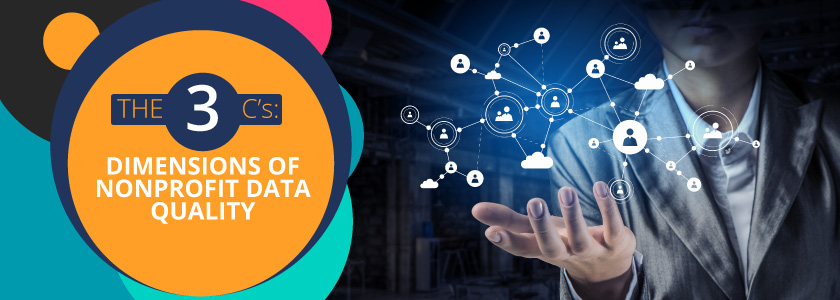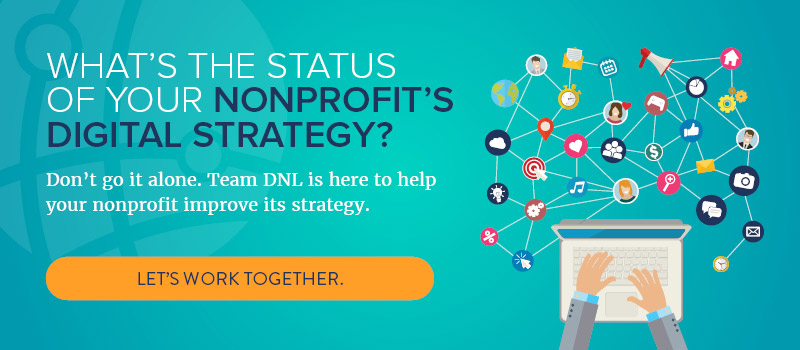Guest post submitted by: Omatic Software, a business specializing in nonprofit data health and integration.
Nonprofits in the second fifth of the Twenty-First Century have an awful lot of data to contend with. Strike that. ‘Contend’ is a discouraging word, and all of the data that you have at your disposal is far more of an advantage than a disadvantage, but only if properly leveraged. Still, there is so much of it and it all comes at you from so many places.
Just think about the fact that online giving grew 75% (that’s close to double) between 2012 and 2018. And that email lists grew by 8% in 2019 and by 40% over the previous three years. And then there are data from marketing activity, events, volunteer endeavors, ticketing systems, list exchanges, and third-party initiatives. And so on. This can be great because it furnishes you with an abundance of demographic and behavioral information about your supporters, which then can be used strategically to build or further relationships. You can use the data to demonstrate – very personally – your continued need for their support. But maintaining so much information can also be more than a little overwhelming.
It’s easy to end up with a lot of unconnected and unintegrated data silos, none of which provide a full picture of a supporter’s/patron’s/constituent’s overall involvement. One system may maintain event history and interests; another, email activity and newsletter preferences; a third, volunteer assignments and hours; a fourth, online donation history. And so on.
Data from all of these sources need to be consolidated into the main CRM database system of record.
When key information remains segregated, fundraising initiatives can be crippled. This is because fundraisers – up and down the pyramid – miss out on fundamental information that can help them build relationships, effect the best possible messaging, and elicit support to further the mission. And worse, when some of that siloed information is stale or just plain wrong, and not updated or corrected, relationships with supporters can be damaged and opportunities missed.
Most often, your nonprofit ends up with unconnected and unintegrated data silos when you use a variety of software solutions to interact with supporters. As an example, you invest in Salesforce as your CRM solution, but fail to take advantage of the apps and integrations available for it. Integration is a sound first step to effective data management. But along the way, you’ll need to consider the three C’s of nonprofit data quality.
The Three ‘Cs’ of Nonprofit Data Quality
The best strategies for effective data quality can boil down to three ‘Cs’ – Currency, Cleanliness, and Completeness. When a nonprofit’s database system of record is current, clean, and complete, data can be used confidently and strategically to drive increased donor acquisition and retention. Cogent messaging and other fundraising interactions can leverage that very data to create a personalized and compelling experience for prospects and existing donors alike.
Data Should be Current
The freshness of a nonprofit’s data will directly inform how they are perceived – and received – by donors and other supporters.
Your nonprofit collects donor data from various sources and systems. If you fail to consolidate that information in a timely manner or if it somehow gets lost in the shuffle, your database can quickly become out of date and stale.
For example, if direct marketing segments are pulled before the most current gift data have been imported from donation pages or from the bank lockbox – current and lapsed donors may be pulled into the wrong segments and sent inappropriate solicitation messaging. If supporters’ event participation is not up-to-date in the main database, they may be sent the wrong event information or not sent anything at all related to the event in question. And, if email (or mail) preferences are not current in the main system, supporters may be sent the wrong email (or mail) at the wrong time (or to the wrong place).
Data Should be Clean
The greatest enemy of credibility with supporters is unhygienic data. This includes everything from erroneous biographical and mailing information, to duplicate records, to names and addresses with improper casing (eg, scarlet oneill rather than Scarlet O’Neill).
Certainly, as a baseline, biographical and mailing data should be accurate. Names and addresses should be spelled properly. Incorrect email addresses will certainly bounce back. With more and more biographical data coming into main systems from external online sources, very often it’s the supporters themselves who unintentionally mistype their own information. They may accidentally include a typo when entering personal information on a donation page or when updating their record online after a change in address or marital status. Donors and even first-time newsletter subscribers have been known to enter information in all lowercase (oneill, mcdaniel, sunset blvd.,) because it’s easier.
Standard import tools typically will not catch these errors and will often create new duplicate records for individuals if, for example, their incoming email address does not match the email address on the existing record.
Think of this scenario – Scarlet O’Neill, a donor already in the system, makes a new online gift of $100, but inadvertently mistypes her email address. The standard web donation import does not match her mistyped email with her actual email, and so incorrectly creates a new (duplicate) record for her but with a bad email address. Plus, her giving history on her actual record is now understated. She also gets no gift acknowledgment because of the erroneous email address. This situation has now become problematic – and ‘unclean’ – on so many levels!
Data Should be Complete
When data is maintained in siloes, nobody within the organization will have a complete picture of their supporters. Just as bad, nobody in the organization can get an effective handle on groups of supporters who have characteristics in common – because information about them is fragmented and maintained separately.
By effectively consolidating data from various source systems – that are being used for various unique purposes – into a single system of record, users across the organization are afforded a full, comprehensive, and complete picture of every supporter. And, just as important, fundraisers and marketers can effectively and confidently gather discrete groups of supporters with common characteristics, so they can be engaged in the most meaningful, effective ways possible.
Three Challenges – One Approach
Effective integration software can ensure that data from all external sources are incorporated into the main database system in a timely and time-efficient manner, so that information is always fresh and current. Depending on the integration platform, such software can also take care of the ‘round trip’, so that the ancillary systems are sure to get updates – eg, street and email address changes or other germane offline information – that come into the main database first.
Integration software built especially for nonprofits can ensure that your system of record is always clean and pristine by using sophisticated matching and scoring criteria to indicate whether a ‘new’ record coming in from an external source is actually already in the main system.
In the ‘Scarlet O’Neill’ example, the integration software would have matched the gift from the person with the mistyped email address with the right donor record, added the gift, and discarded the erroneous data. The donor would have gotten a proper gift acknowledgment in a timely fashion.
Further, the software could also properly ‘case’ person, company, and street names. And, it could translate input abbreviations such as ‘LA’ to ‘Los Angeles’ or ‘Beantown’ to ‘Boston’, etc. (And, yes, people really do enter their data that way.)
Nonprofit integration software makes it easy and effortless to consolidate data from ancillary systems into the main CRM, so that system users always have a complete picture of donors and other supporters. And because it’s an uncomplicated process, databases can be updated daily or as often as is necessary. And, the software can ensure that only new data are added to existing records, that duplicates are not created, but that valid new donor records are.
Unanticipated Strategic Outcomes
The Director of Development Operations at a large nonprofit had at first marveled about her new integration software: how quickly the gift information and biographical updates were getting into the system – no more working overtime or sacrificed weekends or vacations for tedious administrative tasks.
But she soon realized that the true benefit of current, clean, and complete data was as much strategic as it was tactical. High-quality data – integrated into the CRM expediently and conveniently – gave her fundraising colleagues the head start they needed when pulling marketing segments so that campaigns were never delayed. And, they now had the ability to test discrete segments based on timely nuances in supporter behavior. And, the most recent donors could be easily identified and suppressed so as to not get embarrassing solicitations so soon after making a gift.
That’s just one example. Technology is a great approach to maintaining data, but not the only approach. Most important is that data from external sources are added into the CRM system promptly, that records are properly matched, and that new records are only created when appropriate. Examine and clean-up issues like improper casing, bad abbreviations, and misspellings. And, ensure to bring data from all key sources into the CRM database (expediently) in order to furnish users with a comprehensive view of the supporters with whom they work.
About the Author:
Stu Manewith joined Omatic Software five years ago and serves as the company’s Nonprofit Advocacy Director. In that role, he is Omatic’s nonprofit sector domain specialist and subject-matter expert and is responsible for actively promoting and demonstrating Omatic’s position as the nonprofit industry’s leading partner in the areas of data health and integration.
Prior to Omatic, Stu spent 13 years at Blackbaud, working with Raiser’s Edge, Financial Edge, and Blackbaud CRM client organizations as a consultant, solution architect, and practice manager.
Previously, Stu spent the first half of his career as a nonprofit executive, fundraiser, and finance director, working in both the healthcare and arts/cultural arenas of the nonprofit sector. He holds business degrees from Washington University and the University of Wisconsin, and he earned his CFRE credential in 1999.


